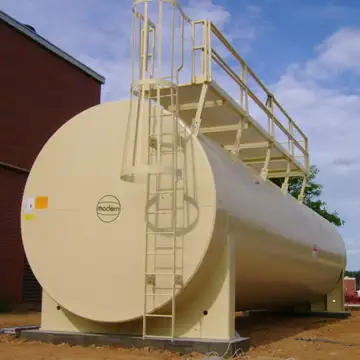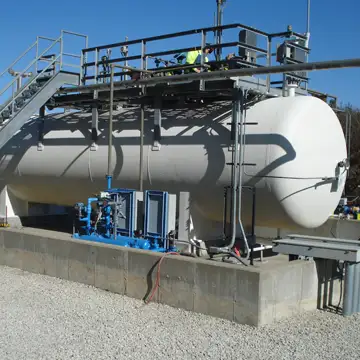How Often Should Storage Tanks Be Inspected? A Comprehensive Guide
Discover how often aboveground storage tanks should be inspected based on industry standards like API 653, STI SP001, and API 510.

The tanks used in various industries like oil and gas, chemicals, and water treatment are important for safely storing essential resources. Given the potential risks associated with improperly maintained tanks—including leaks, spills, and catastrophic failures—the regular inspection of these tanks is essential for safety and efficiency.
The question often asked is how often do these tanks need to be inspected. We'll examine the answer to that question as it relates to three different types of aboveground storage tanks (ASTs).
Overview of Inspection Requirements
Inspection frequencies and practices for storage tanks are primarily governed by environmental regulations and industry standards. Formal inspections (not to be confused with routine inspections) are an important component for meeting the EPA's Spill Prevention, Control, and Countermeasure (SPCC) regulation. The goal is to ensure tanks maintain their integrity over their operational life, preventing incidents that could impact human safety and environmental health. ASTs have specific guidelines that vary significantly based on each tank’s construction, contents, and the risks that are posed.
Specific Standards and Inspection Frequencies
The first thing to consider regarding inspection frequency is the type of AST you have and whether it falls under the API 653, STI SP001, or API 510 standards. Understanding these standards will help you determine how often your tank needs to be inspected.
API 653 Inspection Standard and Frequency

The API 653 standard, developed by the American Petroleum Institute (API), applies to aboveground storage tanks that are field-erected or field-built, made of steel or other metal alloys, and have a diameter of 30 feet or more, or a height of 50 feet or more. These tanks are typically used to store petroleum, chemicals, and other hazardous materials in industrial facilities such as refineries, chemical plants, and terminals.
Regarding tanks that fit within the API 653 standard, it’s best to separate internal and external inspections.
Internal Inspections: The frequency of API 653 internal inspections depends on a range of factors, including the tank's size, age, and the materials it stores. In general, a tank must undergo its first internal inspection 10 years after the construction date, and then normally every 20 years thereafter. If the inspector finds corrosion, pitting or any other indicator that may be of concern, the inspector may determine that a shorter interval to the next internal inspection is required.
External Inspections: According to the API 653 standard, formal external inspections should be conducted at least once every five years for ASTs. However, more frequent inspections may be necessary based on factors such as the age of the tank, operating conditions, and the findings from previous inspections. Tank owners should consult with a qualified inspector to determine the appropriate frequency based on their specific circumstances.
STI SP001 Inspection Standard and Frequency

The STI SP001 Standard, developed by the Steel Tank Institute (STI), is relevant for ASTs that are up to 30 feet in diameter and up to 50 feet tall. It is most commonly used for the inspection of welded carbon or stainless-steel shop fabricated tanks with a capacity of up to 75,000 gallons, but may also include field-erected tanks within the same dimensions and up to 264,000 gallons. The ASTs can be horizontal or vertical.
If your tank has a manufacturer tank plate that states that it was manufactured to the Underwriters Laboratory Standard (UL) or some smaller American Petroleum Institute (API) standards, it likely could be inspected under the STI SP001 standard. You can also check for a standard certification plate. Owner purchase records should also help you determine if your tank is shop-fabricated or field erected.
External and Internal Inspections
Both internal and external STI SP001 inspections are typically conducted at the same time. This is because the inspections are complementary and provide a more comprehensive assessment of the tank's condition.
The frequency of inspections for tanks is determined by their size and category.
Category 1: These tanks are equipped with spill control measures and a continuous release detection method (CRDM) and do not require an internal inspection throughout their lifespan.
Category 2: Tanks in this category have spill control but lack a CRDM, and require internal inspections. The intervals for these inspections vary based on the tank's size. Tanks in Category 2 with a capacity ranging from 5,001 to 30,000 gallons must undergo an internal inspection every 20 years. Tanks holding between 30,001 and 50,000 gallons require these inspections every 15 years.
Category 3: Tanks classified under this category lack both spill control and CRDM, which necessitates more frequent internal inspections. This increased frequency is due to heightened risk factors, such as the tank's bottom being in direct contact with the earth or the absence of secondary containment and leak detection systems.
API 510 Inspection Standard and Frequency

API 510 is a pressure vessel inspection code developed by the American Petroleum Institute. The code applies to most refining and chemical production pressure vessels that have:
- Internal design gauge pressure greater than 15 psig
- Non-refrigerated volume of at least 4 cubic feet
- Design temperature of -50 to 1000°F
Common vessels include reactors, distillation columns, condensers, heaters, boilers, and storage tanks.
Pressure Vessel Inspections
The API 510 code provides mandatory inspection intervals depending on several factors:
- Type of Vessel: More frequent inspection needed for vessels containing hazardous materials.
- Operating Conditions: Vessels in severe environments require more frequent inspections.
- Age of Vessel: Older vessels need to be inspected more often.
From there, inspections are categorized as off-stream or on-stream. Off-stream inspections require taking the vessel out of service, while on-stream allows inspection during operation. Off-stream internal inspections are typically every 10 years, while on-stream external inspections may be every 5 years. The tradeoff is more frequent external on-stream inspections while a vessel remains in service. Facilities must balance production impacts and inspection needs when choosing off-stream vs. on-stream inspection frequencies.
Any repairs or modifications also require inspections. This helps ensure unsafe pressure vessels are identified and remediated.
Who Can Perform Tank Inspections?
Storage tank inspections must be carried out by qualified inspectors who are certified under the standard that is relevant for the tank. Each API and STI standard has a stringent certification process that ensures inspectors have the necessary knowledge and skills to perform inspections according to the standards set by the standards organization, ensuring the safety, reliability, and regulatory compliance of tanks used in the oil, gas, and chemical industries.
Bottom Line
Regular inspections are vital for the operational safety, environmental compliance, and economic efficiency of storage tanks. By adhering to prescribed inspection schedules, tank owners can ensure their assets remain in optimal condition, mitigating risks and extending the lifecycle of their investments.
-- Genesis Environmental Solutions provides API 653, STI SP001 and API 510 tank inspections throughout Illinois, Iowa, Kansas, Missouri, Nebraska, and Oklahoma. We provide AST services for all types of tanks, including fuel oil tanks. All work is carefully documented and compliant with federal, state and local regulations. Contact us today for more information.


